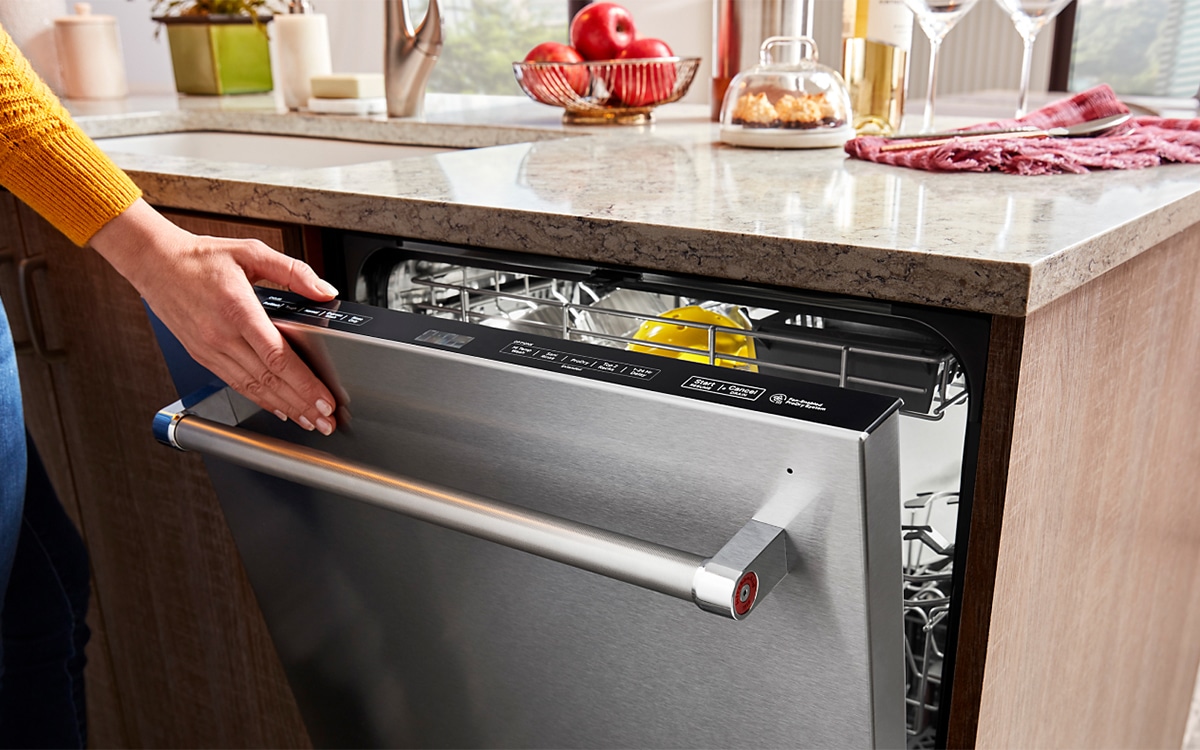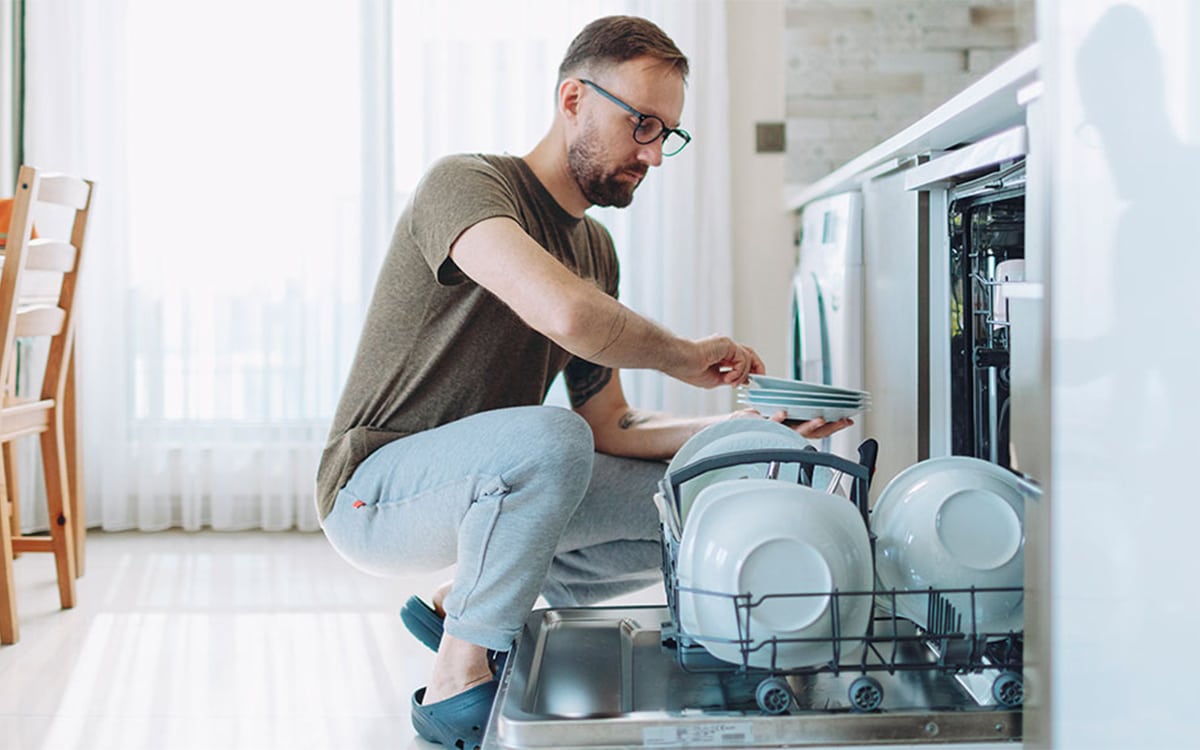But a dishwasher can’t simply handle the task of washing your dishes all alone. Without efficient and effective operation, even the best dishwasher will have trouble doing its job. Ever since dishwashers first entered our kitchens, debates have been sparked about how to efficiently operate them. But it can sometimes seem impossible to tell whether there’s any truth to any common dishwasher tips and tricks. Should cutlery be stored upside down? Should you be rinsing my dishes before loading them?
No doubt, you want to keep your dishwasher running at its very best. If so, you’ve truly come to the best place. With the help of our team of Reliant tech experts, we’re going to find out some of the most important things to avoid when operating your dishwasher. So let’s get right to it!
What Shouldn’t You Do When Operating A Dishwasher?
Don’t Load The Wrong Items!
Of course, certain items simply can’t handle the conditions created within a dishwasher tub. During operation, dishwasher tubs naturally become incredibly wet, and intensely hot. But it’s long been debated just which items can actually go in the dishwasher. So much so that you’ll often find yourself second-guessing every item you load into it, before eventually resorting to handwashing everything! Let’s go through some of the most important items that absolutely should be washed carefully by hand!
Prep Knives
For the most part, it’s best to wash prep knives by hand. Prep knives are incredibly sharp, and thus they pose two potential problems. First, prep knives can actually be easily dulled by the force of the water within the dishwasher. While your knives may come out incredibly shiny, you may also find that they are slowly dulled more and more with each clean.
Be careful with sharp knives in the dishwasher! If you’re not careful when unloading it, you may run the risk of accidentally cutting yourself on them! It’s much safer for yourself, and the knives, to wash them by hand!
Secondly, prep knives also pose a very real hazard to your safety. When unloading your dishwasher, pointy prep knives run the risk of accidentally cutting you! If you simply must load your knives into the dishwasher, we strongly recommend storing them with the blades pointed into the basket!
Wooden Items
Wood simply can’t handle the conditions of a dishwasher. When wood becomes wet, it naturally expands slightly, thanks to its porous properties. This means that wood actually runs the risk of warping entirely when placed into the dishwasher.
If water was not a threat to wood, then heat still would be. The extremely hot conditions of the dishwasher would also cause the wood to expand, and thus increase the chance of the wood warping.
When wood expands due to being wet, it then runs the risk of cracking when it dries. This is because the sudden change in moisture levels will shock the wood. A wooden chopping board placed into the dishwasher could come out in multiple pieces if you’re not careful!
It’s best to wipe down wooden items by hand, to prevent water damage and warping!
Certain Plastics
Generally, it’s best to avoid placing plastics in the dishwasher. Only certain plastic products are actually safe for insertion into your dishwasher. These are usually noted with a “Dishwasher safe” label.
Ordinary plastics really run the risk of melting or warping when exposed to such high temperatures. Trying to wash away melted plastic from your dishwasher racks is an incredibly difficult task.
The top rack of the dishwasher is the furthest from the heating element. As such, it should be used to store some of your more delicate dishwasher items that may be damaged by high temperatures.
When placing dishwasher-safe plastics in the dishwasher, you should only load them in the top rack. The top rack is farthest away from the heating element, and thus items stored there are far less likely to be damaged.
Crystal
Crystal products are extremely delicate. This is partly what makes them such a sought after item for the home. Because they’re so delicate, this means that they simply can’t withstand the strain of the dishwasher. The intense heat runs the risk of completely shattering the surface of crystal products. And even the force of water jets can be enough to leave hairline cracks behind!
Crystal products also have a very unique tendency to “Cloud” as a result of a dishwasher cycle. This results in a strange cloudy residue sticking to the surface of the crystal itself.
Crystal is very costly and delicate, so you’re better off carefully handwashing it every time!
Nonstick Products
Nonstick products are coated in a thin layer of non-stick material that helps to make them so smooth. The problem is, if it’s not taken care of, this non-stick coating can very easily be peeled off. This is why non-stick products should never be used with metal utensils.
The non-stick coating of such products can, unfortunately, be chipped away in the dishwasher. This is caused by both the heat of the tub and the force of the water from the jets.
Nonstick products are also often very large. Thus, it’s generally best to wash them by hand. Larger products like pans and baking trays can take up a lot of space in your dishwasher, and make it much harder for the water to travel. This results in an unfinished clean!
Anything Delicate!
If you’re ever in doubt about placing anything precious into the dishwasher, we’d recommend against it. It’s much better to be safe than sorry after all!
Some items like fine china are extremely delicate and thus are likely to be easily damaged by the conditions of a dishwasher.
Don’t Overload The Unit
Dishwashers are incredibly useful. They’re designed to take on massive loads of dishes and give them all a great clean. However, because they’re so useful, the natural tendency is to completely overfill them! After all, why leave that one plate waiting around when you could stuff it in place and get everything done in one go?
Unfortunately, though understandable, it’s thinking like this that leads to overloading! When you overload your dishwasher, it becomes much harder for water to travel across the central tub. In turn, this results in a much less satisfying clean. Small pockets of food can be trapped and sheltered from the water, completely negating the purpose of running the dishwasher in the first place!
You should avoid ever overfilling your dishwasher. You’ll know you’re overfilling your dishwasher if you ever have trouble slotting a dish into place. Overfilling results in an unfinished cleaning job!
Luckily, it’s quite easy to tell if you’re overloading your dishwasher. If at any point you have trouble fitting a dish into either of the racks, then it’s likely that it’s already at full capacity. Don’t forget that dishwasher racks are designed in such a specific way for a reason. The gaps are there to allow water to travel. If those gaps are covered, then the water can’t get across the tub!
Most dishwasher racks come with designated spaces for specific dishes. The pronged sections on the bottom rack, for example, are there for holding your plates up vertically! Each of these prongs is designed to hold one plate. As such, you’d be overstuffing the unit by putting two plates behind each set of prongs. If there isn’t a dedicated space for each item you place into the dishwasher, it likely shouldn’t be there!

Don’t Throw Items In Randomly
Loading your dishwasher is actually something of an art form unto itself. If done improperly, you’ll end up pulling out a bunch of still-dirty dishes that are dripping with water! This is because placing the wrong items in the wrong spots can make it difficult for the water jets to send water across the tub.
Starting with the bottom rack, you’ll want to load your plates and bowls using the prongs and angle them sufficiently. Insufficiently loaded bowls, in particular, can prevent water from travelling, as the curved interior sends water right back down to the bottom of the unit.
If your dishwasher has a basket for silverware and cutlery, you’ll also want to make sure it’s loaded properly. Spoons and knives should be placed with the handles down, and should not be placed too close together. When these items rest too close to one another, they run the risk of “Nesting”. This prevents water from reaching every inch and fully cleaning them!
The top rack is generally reserved for some of your smaller items, especially those with curved interiors. Cups, mugs, small bowls, and glasses all have curved insides that can prevent effective operation when placed in the bottom rack. The top rack is also great for slightly more delicate items and certain plastics. This is because it’s slightly cooler, as a result of its distance from the heating element.
Only some dishwashers come with an extra third rack. Most often the third rack is extremely narrow and is positioned just above the top rack. As a result, it’s best used for some of your other utensils, such as spatulas and extra cutlery.
Don’t Bother Rinsing
For generations, dishwasher users have been pre-rinsing their dishes before loading them into the dishwasher. It’s such a natural part of the dishwasher loading process that many of us aren’t even aware when we’re doing it. It’s become an automatic function. However, modern dishwashers actually don’t even require you to rinse your dishes before loading them. In fact pre-rinsing your dishes is a significant waste of water!
The reason why we once needed to pre-rinse dishes was simply because dishwashers were less effective. The smallest amount of food waste could get a vintage dishwasher sputtering after getting stuck in the drainage. Nowadays, dishwashers are actually specifically designed to deal with even slightly larger bits of food waste! Small food crumbs, bits of pasta sauce, and oil coatings on plates and bowls are all fair game. Modern dishwashers can effectively filter out these pieces of food and keep drainage clear!
Rinsing often goes hand in hand with loading a dishwasher. But there’s no need for it anymore. Modern dishwashers can deal with small amounts of food waste. Pre-rinsing is simply a massive waste of water and electricity!
Because dishwashers can now deal with more food waste, there’s no need for pre-rinsing. Pre-rinsing dishes before placing them in the dishwasher is a waste of water and energy. Your dishwasher will be able to do the job using less water and electricity, saving you money in the long run!
However, it’s worth noting that larger pieces of food still can’t be processed by even the best dishwashers. If you have a plate with plenty of large chunks of food still left on it, simply scrape the extra bits away into the bin! This saves water and also prevents any trouble in the dishwasher itself.
Frequently Asked Questions
What Should You Not Do When Using A Dishwasher?
The most important thing to not do when using a dishwasher is to overload it. Overloading your dishwasher makes it difficult for the hot water to travel through the tub. This can also occur when loading inefficiently. For instance, placing mugs in the bottom rack can stop water in its tracks, leaving your plates dirty. And make sure not to put anything delicate in there!
What Damages Dishwashers?
Many cases of damaged dishwashers are a direct result of loading your dishes when they’re still covered with large amounts of food. While you don’t need to pre-rinse your dishes, large pieces of food should be scraped into the bin. If these large pieces of food enter the drainage system, they run the risk of blocking it!





